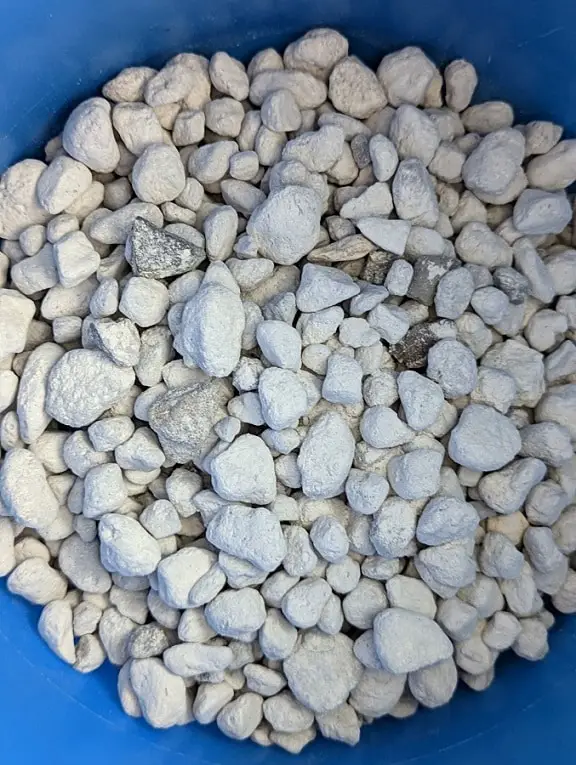Seachem has two similar biological filter media currently available with Matrix and Pond Matrix.
You can take a look at this comparison guide at Aquarium Blueprints to see what the major differences are between these two products.
Quick Summary
When compared to the Seachem Matrix, the Seachem Pond Matrix provides at least twice the amount of surface area for beneficial bacteria. Therefore, the Pond Matrix should be better at providing biological filtration for ammonia, nitrites and nitrates reduction.
With that said, the Matrix uses smaller pebbles, which makes it easier to fit and maximize the limited space if you have a smaller filter basket, filter compartment, fish tank or pond.
Pricing
You can check out the current price tags for the two biological media in this versus guide on Amazon via the following links:
- Seachem Matrix(#CommissionsEarned)
- Seachem Pond Matrix(#CommissionsEarned)
Packaging Sizes
You can find the available packaging sizes for both of the filter media products below:
Seachem Matrix:
- 250 mL
- 500 mL
- 1 L
- 2 L
- 4 L
Seachem Pond Matrix:
- 1 L
- 2 L
- 4 L
- 20 L
Pebble Sizes
When it comes to the individual pebble size, the Seachem Matrix is a lot smaller when compared to the Seachem Pond Matrix. Therefore, the Matrix is more suitable if you have a smaller filter compartment or basket as you can maximize the limited space.

Surface Area
According to internal testing done by Seachem, Matrix provides surface area at a rate of more than 700 m2/L. The Pond Matrix is even better as it features surface area at a rate of 1,600 m2/L.
For the uninformed, beneficial bacteria will colonize surfaces all around your tank, including on these pebbles. These microorganism will help consume ammonia, nitrites and nitrates.
Recommended Directions
When it comes to how much of these biological filter medias you should use in your fish tank or pond, Seachem recommends that you add 250 mL of Matrix for every 50 gallons or 200 liters of tank water.
For Pond Matrix, you can add 500 mL for every 50 gallons or 200 liters of tank water.
Ammonia Reduction
Uneaten fish food, fish excrement and other organic wastes will eventually turn into ammonia, a toxic compound that will cause a lot of health issues even in small traces.
Fortunately, there is a natural bacteria that will fully consume ammonia. After this colony is established in for fish tank once it has been fully cycled, you should not get any ammonia readings when using an aquarium test kit.
Because the Pond Matrix provides more surface area for ammonia-consuming bacteria to colonize, it is better at ammonia reduction especially if you have a lot of fish and/or fish that produce a lot of organic wastes.
Nitrite Reduction
The bacteria that consume ammonia will convert it to nitrites, which is also a toxic compound for the fish and other inhabitants in your aquarium.
Thankfully, there is another type of bacteria that will completely consume nitrites once your tank has been fully cycled.
This nitrite-eating bacteria should also grow on the same surface area as the ammonia-consuming bacteria. Since Pond Matrix provides at least twice as much surfaces than the competition, it should also better at reducing nitrites.
Nitrate Reduction
The bacteria that consume nitrite will convert it to nitrates, which is the final stage of the nitrogen cycle. The nitrate compound is not as deadly as ammonia or nitrites. With that said, you should keep its level to below 40 ppm (or 20 ppm if you are keeping for sensitive species).
Both the Matrix and Pond Matrix feature internal chambers that are devoid of oxygen, which meets the requirement to grow the nitrate-consuming bacteria.
Thanks to it higher porosity, the Pond Matrix should provide more surface area for this bacteria type to grow on when compared to the Matrix.
Maintenance
If the microscopic pores of Matrix and Pond Matrix gets blocked or clogged, then the beneficial bacteria living inside won’t be able to consume any ammonia, nitrites and nitrates.
Therefore, you need to occasionally rinse any buildup off of these pebbles, preferably during a water change.
The good news is that these pebbles won’t break down at all, which means that both biological filter medias should last you indefinitely with proper care.
Resources:
